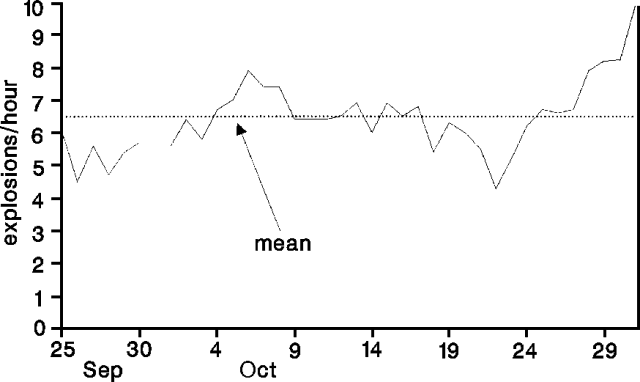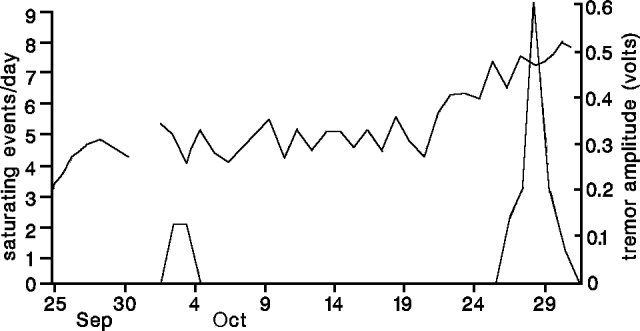Report on Stromboli (Italy) — October 1991
Bulletin of the Global Volcanism Network, vol. 16, no. 10 (October 1991)
Managing Editor: Lindsay McClelland.
Stromboli (Italy) More frequent explosions; new zone of fumaroles
Please cite this report as:
Global Volcanism Program, 1991. Report on Stromboli (Italy) (McClelland, L., ed.). Bulletin of the Global Volcanism Network, 16:10. Smithsonian Institution. https://doi.org/10.5479/si.GVP.BGVN199110-211040
Stromboli
Italy
38.789°N, 15.213°E; summit elev. 924 m
All times are local (unless otherwise noted)
The number of recorded explosion shocks increased irregularly through October (figure 23), a continuation of the generally increasing trend that followed the low activity of mid-July to mid-August. Tremor amplitude also increased (figure 24). The number of seismometer-saturating events was quite low and concentrated during the last week of October, when tremor was stronger and explosions were more frequent.
 |
Figure 23. Average number of explosion shocks/hour at Stromboli, 25 September-31 October, 1991. The mean value for the period is shown by the dotted line. Courtesy of M. Riuscetti. |
 |
Figure 24. Number of seismometer-saturating events/day (lower curve) and average daily tremor amplitude in volts (upper curve) at Stromboli, 25 September-31 October, 1991. Courtesy of M. Riuscetti. |
A team from the Univ di Udine climbed the volcano during the first week in October. Two vents were active in Crater 1, the first near the E rim, the second a 30-m-high cone on its NW flank (facing the Sciara del Fuoco). Explosions produced plumes 100-150 m high, and ejected lapilli and sand-sized tephra. Crater 2 was still marked by two radial fissures with clearly visible night glow, but its rim was no longer well-defined. Cone 1 in Crater 3 continued to produce white vapor from two vents. The westernmost vent of Crater 3 appeared to be the most active, and was at the center of a rapidly enlarging chasm. It ejected clouds of black, sand-sized tephra to a maximum height of 300 m.
Along the ridge extending E from Pizzo sopra la Fossa (the observation point SE of the active craters), a zone that once consisted of a few isolated hot spots had evolved to a thermal anomaly in September (16:08) and a continuous line of fumaroles in October.
Geological Summary. Spectacular incandescent nighttime explosions at Stromboli have long attracted visitors to the "Lighthouse of the Mediterranean" in the NE Aeolian Islands. This volcano has lent its name to the frequent mild explosive activity that has characterized its eruptions throughout much of historical time. The small island is the emergent summit of a volcano that grew in two main eruptive cycles, the last of which formed the western portion of the island. The Neostromboli eruptive period took place between about 13,000 and 5,000 years ago. The active summit vents are located at the head of the Sciara del Fuoco, a prominent scarp that formed about 5,000 years ago due to a series of slope failures which extends to below sea level. The modern volcano has been constructed within this scarp, which funnels pyroclastic ejecta and lava flows to the NW. Essentially continuous mild Strombolian explosions, sometimes accompanied by lava flows, have been recorded for more than a millennium.
Information Contacts: M. Riuscetti, Univ di Udine.

